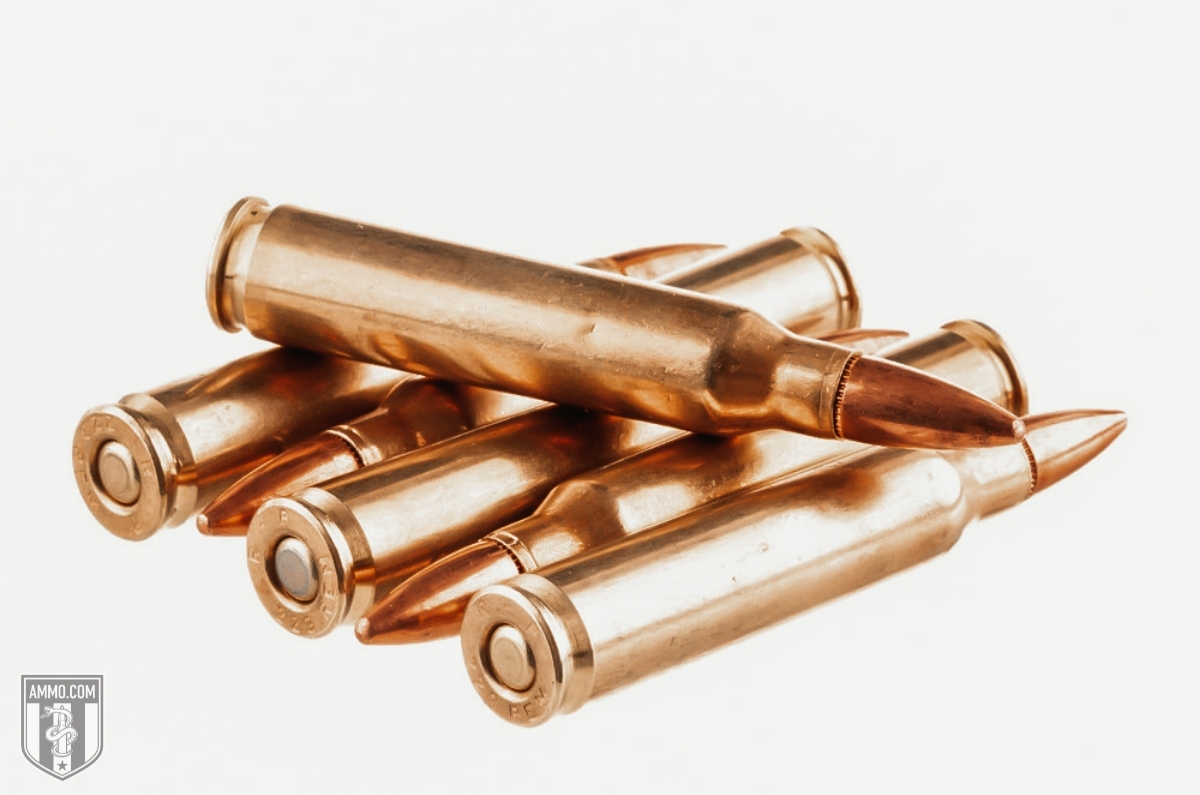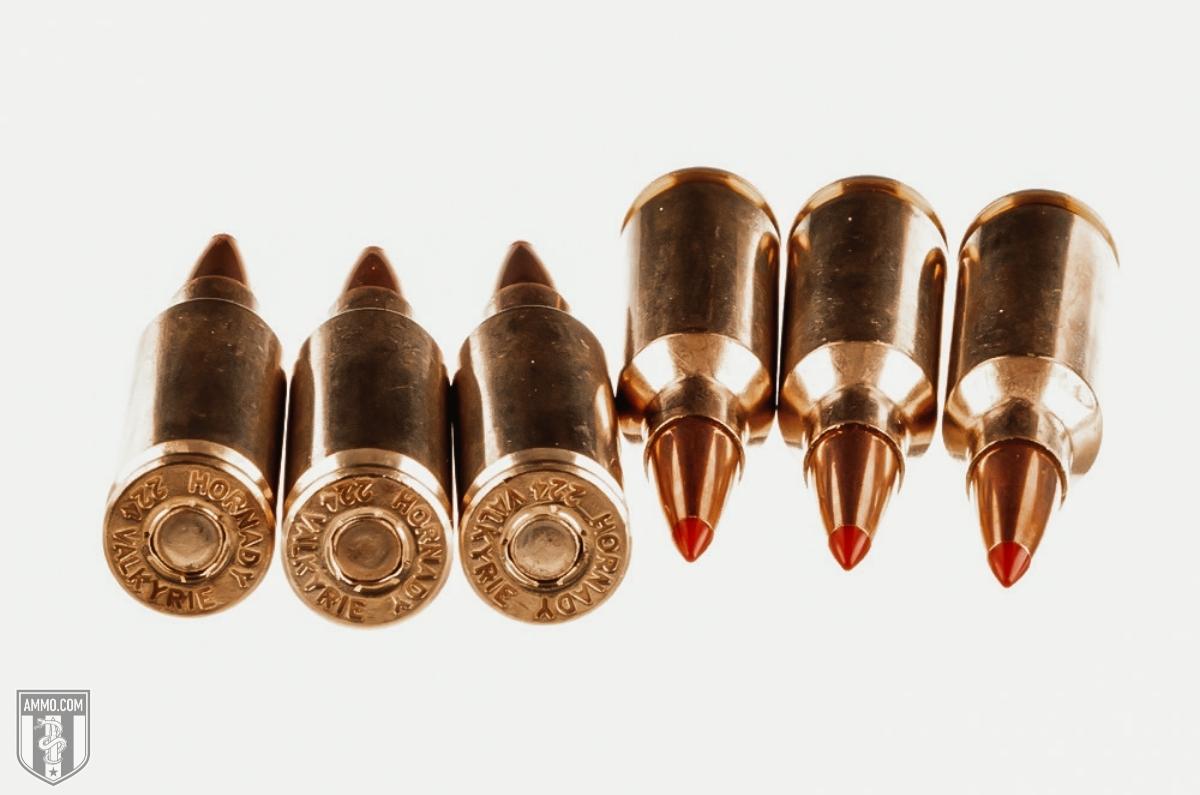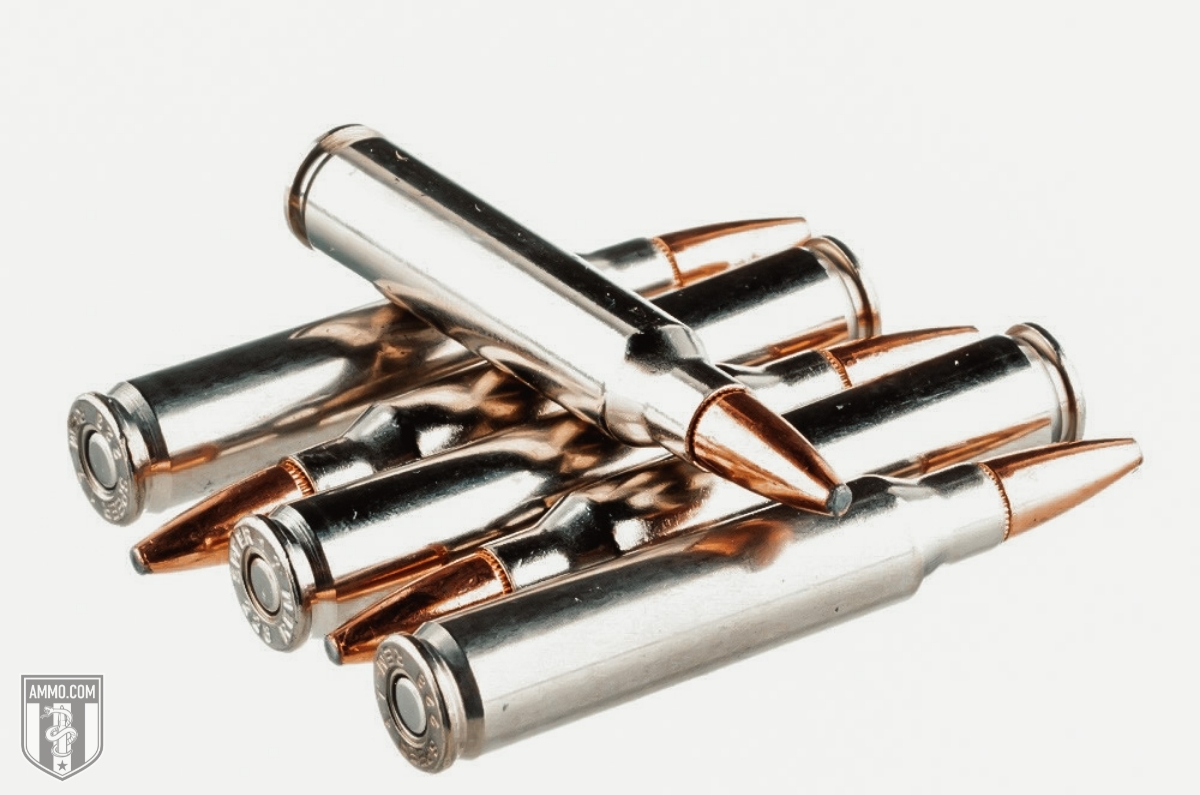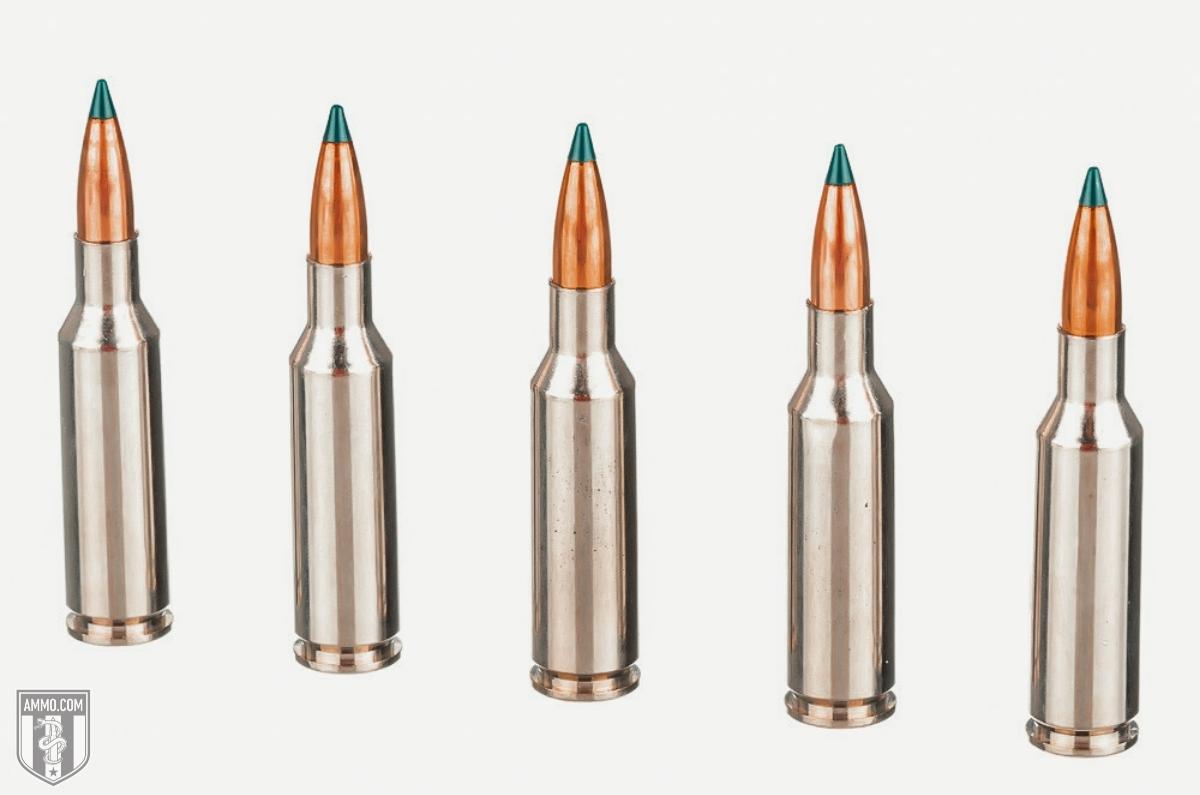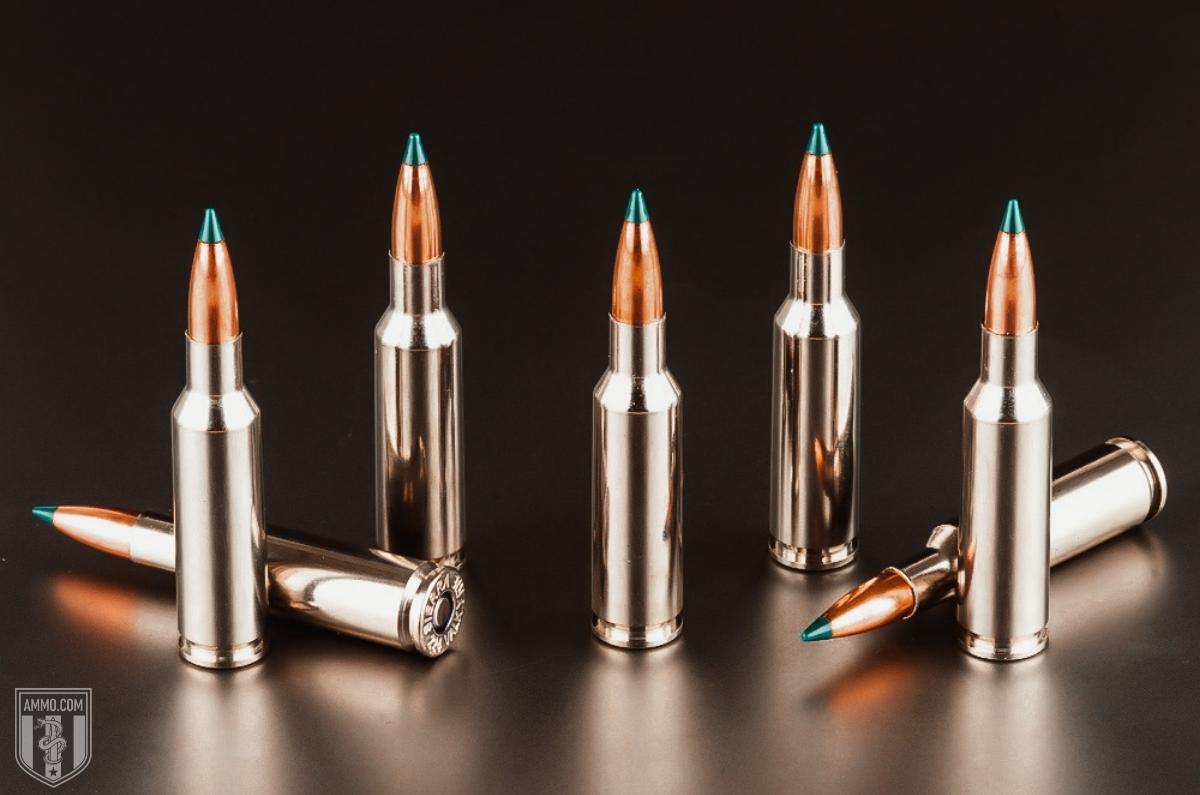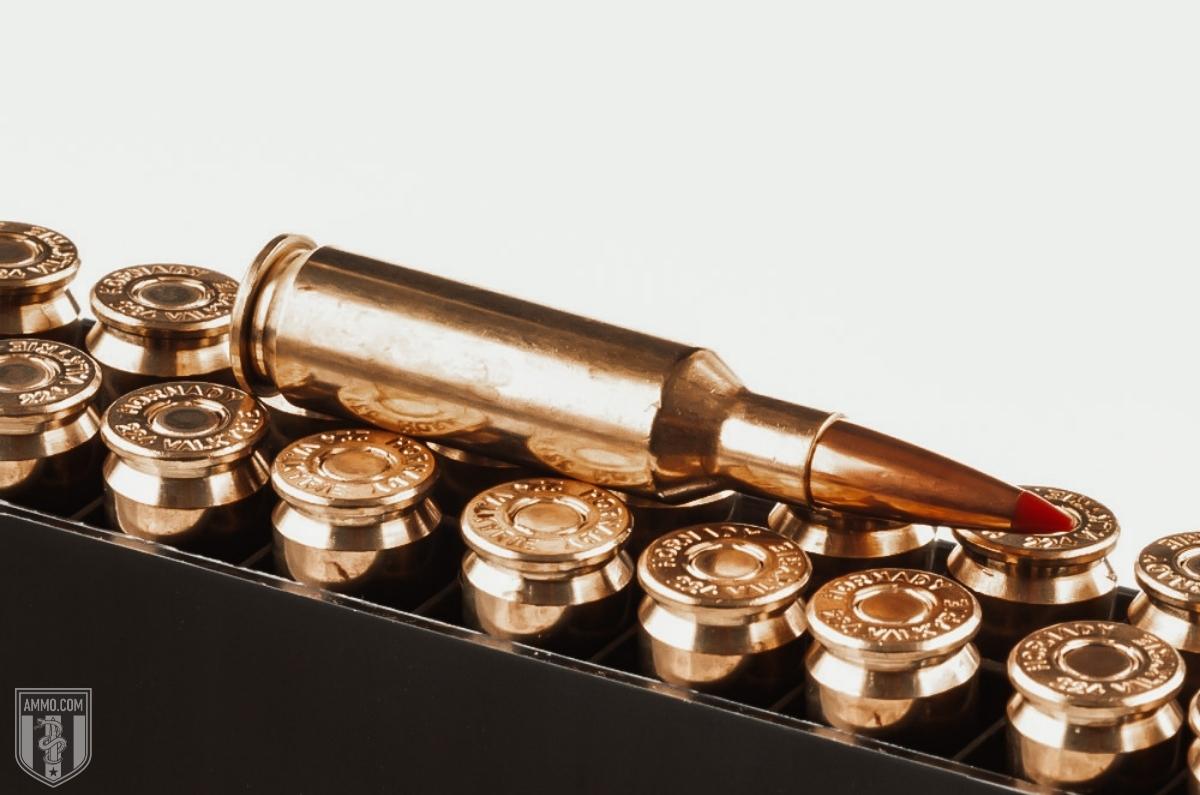224 Valkyrie vs 223: Stretching the Capability of the AR-15
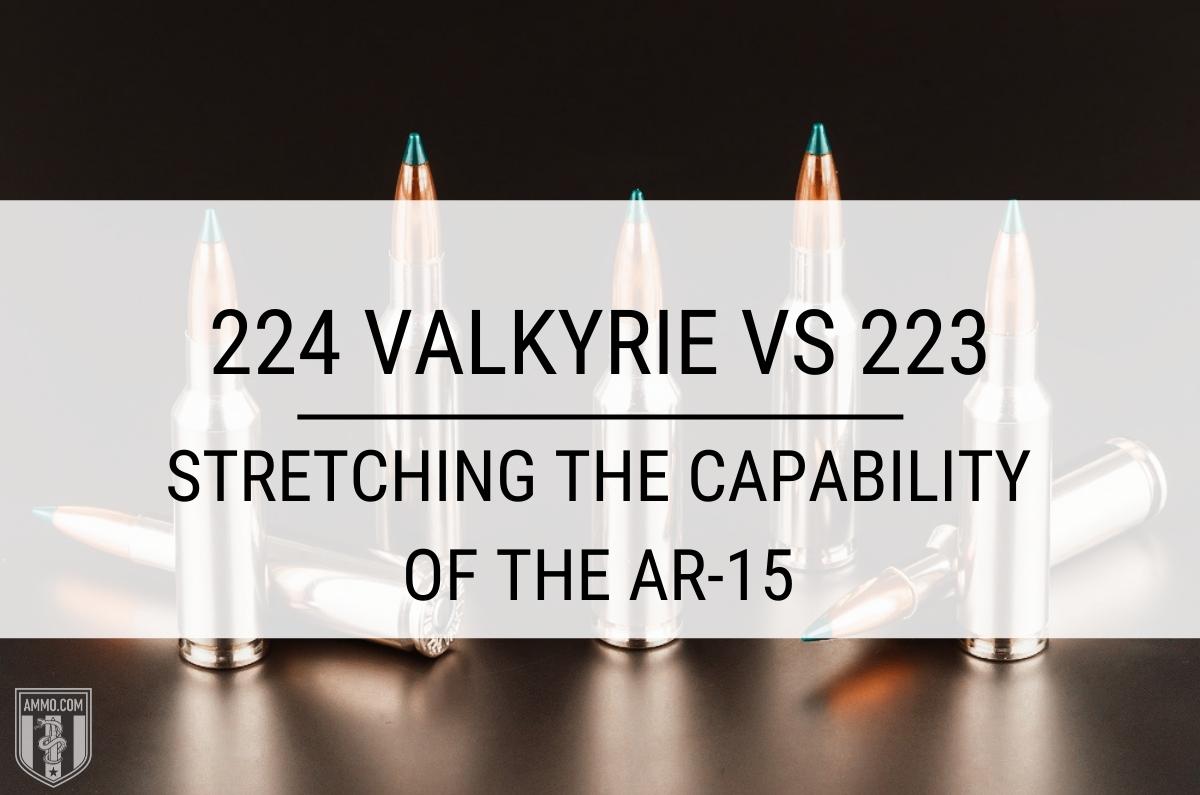 The 224 Valkyrie and 223 Remington are two 22-caliber centerfire rifle cartridges that were designed for use in the semi-automatic AR-15 platform.
The 224 Valkyrie and 223 Remington are two 22-caliber centerfire rifle cartridges that were designed for use in the semi-automatic AR-15 platform.
With the proliferation of the AR-15 as one of the most popular modern sporting rifles on the planet, the 223 Remington has in turn become one of the most common centerfire rifle cartridges on the market today.
Even though the 223 can reliably reach ranges upwards of 800 yards with proper match-grade loads, some shooters wanted to go further and hit targets out to 1,000 yards and beyond.
Adapting new calibers to the AR-15 is nothing new, as the 6.5 Grendel, 6.8 SPC, and 6.5 Creedmoor have all seen mild success in the rifle platform and can easily hit targets at 1,000 yards. However, these cartridges have heavier recoil, and some shooters wanted to maintain the lower recoil impulse of the 0.224” diameter bullet while still reaching out to 1,000 yards and beyond.
Enter the 224 Valkyrie, which can maintain supersonic flight and MOA-level accuracy at 1,300 yards with proper loads. Topped with the 90-grain Sierra Matchking bullet, the 224 Valkyrie was developed by Federal Ammunition to answer the call of long range precision shooters who wanted to use their AR-15’s to hit targets beyond 1,000 yards.
Although the 224 Valkyrie is superior to the 223 Remington in virtually every ballistic criterion, is it really worth it to convert your AR-15 to fire the new 224 Valkyrie ammo?
In this article, we will compare the 224 Valkyrie vs 223 to give you a better understanding of each cartridge and help you decide which rifle cartridge is ideal for your needs.
What is the Difference Between 223 and 224 Valkyrie?
The difference between 223 and 224 Valkyrie is their effective range and the bullet weights they fire. The 224 Valkyrie was designed to shoot heavier bullets up to 1,300 yards while the 223 excels at firing lighter bullets at ranges at or below 800 yards.
A Note on Nomenclature
Please note that within this article we will refer to the 223 Remington (223 Rem) and the 5.56x45mm NATO round interchangeably. There are differences between the two and you can read about them in this article: .223 vs 5.56
In short, a 223 Rem can safely be fired from a rifle or handgun chambered in 5.56, however the opposite is not true.
Cartridge Specs
When evaluating two long range precision rifle cartridges, it’s a good idea to analyze the cartridge specs to gain more knowledge of each.
Probably the biggest difference between the 223 Rem and 224 Valkyrie is the base diameter. As the 224 Valkyrie cartridge is based off the 6.8 SPC, the 224 Valk has a base diameter of 0.421” while the 223 is a bit smaller with a base diameter of 0.376”. This means that the 224 Valkyrie is too wide to fit in standard 5.56 NATO magazines for the AR-15, and 6.8 SPC mags will need to be use for 224 Valkyrie.
The 224 Valkyrie case length is shorter than the 223 Rem so that longer, heavier bullets can be loaded in the 224 case while maintaining the maximum 2.26” overall length required to fit in the AR-15 platform. If the overall length were longer, then a heavier and more expensive AR-10 receiver would be required.
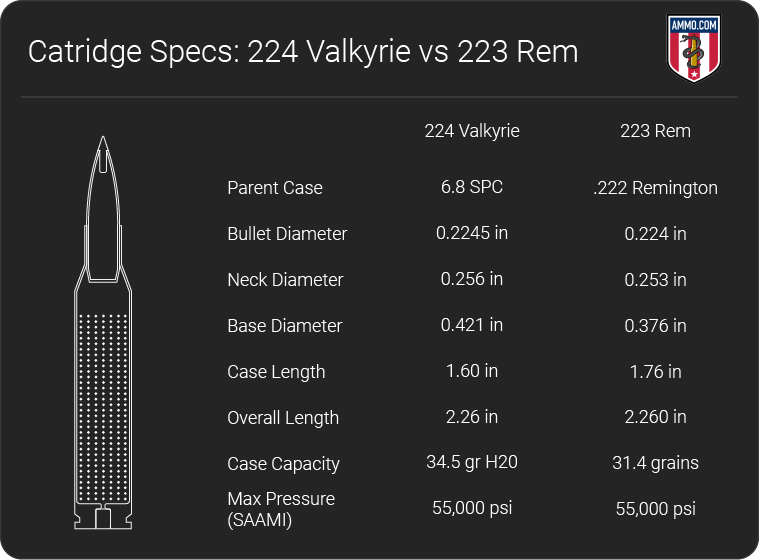
The 224 has a few grains more case capacity than the 223, but otherwise the remainder of the specs are the same. In terms of bullet diameter, both fire a 0.224” bullet
Recoil
The 224 Valkyrie and 223 Remington are both known for having exceptionally mild recoil. Most shooters would have zero issues spending a whole day at the range shooting either.
However, if someone is EXTREMELY recoil sensitive, then the 223 Remington is the better choice as it has 4 ft-lbs of felt recoil on average, compared to 6.5 ft-lbs of felt recoil for the 224 Valkyrie. The difference is primarily due to the 224 Valkyrie firing heavier bullets, like the 90 grain Sierra Matchking projectiles that the cartridge was designed for.
It should be noted that even though the 223 Reminton technically has less recoil, most shooters will not be able to discern much difference between the two.
Muzzle Velocity and Kinetic Energy
Muzzle velocity, measured in feet per second (fps) is the speed at which the bullet leaves the barrel of the firearm. Generally, a longer barrel length will generate a higher muzzle velocity because it allows for a more complete powder burn.
Muzzle energy is measured in foot-pounds (ft-lbs) and is a measurement of how much force a bullet delivers to its target at a given range.
For the purpose of comparison, we will consider the Gold Medal Match variety from Federal Ammunition. These rounds are topped with Sierra Matchking (SMK) projectiles that are well known for their accuracy, consistency, and precision when it comes to long-range shooting.
For 223 Remington, one of the most popular loads is the Federal 77 gr SMK variety, as this is the heaviest bullet that can be loaded into a standard AR-15 magazine. For the 224 Valkyrie, we will consider the 90 gr SMK, as this is the bullet the cartridge was built around.
For muzzle velocity, there is virtually no difference between the 223 Remington and 224 Valkyrie for these two loads. The 223 Rem has a muzzle velocity of 2,720 fps while the 224 Valkyrie clocks in at 2,700 fps. Considering the 224 Valkyrie is firing bullet that is 13 grains heavier and sacrificing only 20 fps, that’s impressive to say the least.
Although there is no discernable muzzle velocity advantage, kinetic energy is a different story entirely.
As the 224 Valkyrie fires a heavier bullet, it has higher muzzle energy compared to the 223 Remington. The 224 Valkyrie has 1,457 ft-lbs of muzzle energy compared to 1265 ft-lbs for the 223 Remington.
Trajectory
Trajectory is how we quantify a bullet’s flight path as it travels downrange measured in inches of bullet drop.
Obviously, a flatter shooting cartridge is preferred for long-range shooting, as a shooter will require fewer adjustments to their optics to compensate for bullet drop. Having a flatter trajectory also means that a cartridge will be more forgiving of ranging mistakes.
One of the major selling points on the 224 Valkyrie is its flatter trajectory compared to the 223 Remington.
For the purpose of this comparison, we will stick with the Federal Premium Gold Medal Match ammo discussed in the previous section. All calculations were performed using the Hornady Ballistic Calculator.
Assuming a 100 yard zero for both rifle cartridges, at the 500 yard marker the 224 Valk has experienced -55.6” of bullet drop compared to -64.3” of bullet drop for the 223 Remington. But the 224 Valkyrie has barely spread its wings at 500 yards!
At the 1,000 yard marker, the 224 Valkyrie has a bullet drop of -345.8” compared to -475.7” for the 223 Remington.
The main reason for the drastic differences in trajectory at 1,000 yards is that the 224 Valkyrie is still supersonic, while the 223 Rem has dropped below subsonic speeds. For reference, the speed of sound is 1,125 fps, so any velocity above this is considered supersonic.
Once a bullet drops into subsonic speeds, external forces like gravity more greatly affect the bullet’s flight as illustrated by the example above. Furthermore, accuracy generally begins to suffer when a bullet goes subsonic.
The 77 grain bullet fired by the 223 Remington rifle cartridge went subsonic around 850 yards. The 224 Valkyrie was specifically developed for long-range shooting, so it is not surprising that its trajectory was superior to the 223 Rem.
Ballistic Coefficient
Ballistic coefficient (BC) is a measure of how well a bullet resists wind drift and air resistance. Put another way, it’s a numeric representation of how aerodynamic a bullet is. A high BC is preferred as this means the bullet will buck the wind easier.
Generally, heavy bullets will have a higher BC as it takes more force to disrupt the flight of a heavier bullet than a lighter one. Ballistic coefficient varies from bullet to bullet based on design, weight, and other factors that are beyond the scope of this article.
The 224 Valkyrie was designed to fire heavy bullets like the 90 grain Sierra Matchking bullet for its exceptional ballistic coefficient. Therefore, it should not come as a surprise that the 224 Valkyrie is generally superior in terms of ballistic coefficient.
For the 224 Valkyrie, its 90 gr SMK bullet has a BC of 0.563 which is insanely high for a 0.224” bullet diameter. For the 223 Remington and its 77 gr SMK bullet, the measured BC is 0.372.
We saw the effect of high ballistic coefficient in the trajectory section above, but how does this translate into wind drift?
Assuming a 10 mph crosswind, at 500 yards the 224 Valkyrie has experienced 16.9” of wind drift compared to 27.9” for the 223 Remington.
The added bullet weight of the 224 Valkyrie cartridge really shines when it comes to ballistic coefficient and fighting wind drift.
Sectional Density
Sectional Density (SD) is the measure of how well a bullet penetrates a target. This is extremely important when hunting big and medium sized game, as you need a bullet that can punch through thick hide, bone, and sinew.
Sectional density is calculated by comparing the bullet weight and the bullet diameter. The higher the SD the deeper the bullet will penetrate into the target. This is a simplified view of penetration as there are other factors to consider, such as bullet expansion and velocity.
The 224 Valkyrie will generally have higher sectional density as it can fire heavier bullets.
Since both cartridges fire the same diameter bullet, penetration will be dependent on the kinetic energy that each is carrying. As noted in the previous section on Kinetic Energy, the 224 Valkyrie and its heavier projectiles generally have higher kinetic energy than comparable 223 Remington loads.
This means that the 224 Valk will put more kinetic energy into the same area as the 223 Rem. The 90 gr SMK bullet for 224 Valkyrie has a sectional density of 0.256 vs 0.219 for the 77 gr SMK for 223 Remington.
Barrel Length and Twist Rate
Barrel twist rate is a term that is often thrown around in the shooting world but sometimes misunderstood.
When a bullet is fired, it travels down the barrel and begins to spin due to the rifling. This spin stabilizes the bullet in flight, increasing accuracy and consistency.
For rifle barrels, twist rate is expressed as a ratio of rotations per length of barrel. For example, a 1:7 twist barrel will cause a bullet to experience 1 full rotation per 7 inches of barrel length.
Typically, longer, heavier bullets require a faster twist barrel while lighter bullets work better in a slower twist barrel. This means that your barrels twist rate will directly impact which bullet weights your rifle will fire best.
For your standard 16-18” barreled AR-15 chambered in 223/5.56 NATO, you will generally find there are three different twist rates available: 1:9, 1:8, and 1:7.
By far, 1:9 and 1:7 are the most popular twist rates available through 1:8 is beginning to pick up steam. The 1:9 twist rate is generally considered ideal for a 62 grain bullet or lighter, while the 1:7 is the twist rate of the modern M4 carbine and can reliably stabilize a 69 grain bullet and up. The 1:8 twist barrel is a “middle of the road” option that can stabilize projectiles between 62 and 77 grains.
For the 224 Valkyrie, there is generally only one twist rate a shooter should consider, and that is the 1:7 twist as the faster twist rate is needed to stabilize heavier bullets.
One other item to consider when purchasing a 224 Valkyrie is barrel length.
Many shooters who own an AR-15 platform like it for its light weight and shorter barrel. This makes for a very maneuverable rifle that is easy to carry long distances and through thick brush. However, short barrels are not necessarily the best option when you want to shoot long distance.
Bullets fired from a short barrel will generally have lower muzzle velocity than those fired from longer ones. This is due to the bullet exiting the barrel before it has reached its full velocity.
For a 224 Valkyrie, a 22-24 inch barrel is required for the bullet to reach its full muzzle velocity and potential. However, humping around a 24” barreled rifle in the woods is not the simplest thing to do.
This means that when you plan out your 224 Valkyrie rifle, it’s a good idea to know what you plan to do with it before selecting a barrel length. If you plan to shoot out past 1,000 yards in long range shooting competitions, then you need to seriously consider a 24 inch barrel. However, if you are planning on varmint hunting below this distance, you can probably get away with a shorter barrel.
Hunting
The 223 Rem has a long and storied history as being an extremely effective varmint round. Rounds like the Nosler Ballistic Tip and Hornady V-MAX have made the 223 Reminton a potent choice when you plan on ridding your property of prairie dogs, coyotes, groundhogs, or any other small varmint that dare cross your path.
Although the 224 Valk is a relatively new cartridge, it performs just as well as the 223 in terms of varmint hunting.
The 224 Valkyrie cartridge has the added ability to fire heavier bullets, raising the question if it can be used for larger game like whitetail. The ethical question of using a 0.224” bullet diameter has been debated ad nauseum on the Internet and most states require a 0.243” minimum bullet diameter for deer hunting.
However, the Federal Ammunition 90-grain Fusion bullet would be a good option for this purpose should you be allowed to use a 22-caliber round for whitetail hunting. The 90-grain Fusion can maintain 1,000 ft-lbs of energy out to 200 yards and provide adequate expansion to ethically harvest medium sized game animals.
But just because you can do a thing, it does not mean that you should. Most states and territories prohibit the use of anything below a 0.243” diameter bullet, so sadly the 224 Valk and 223 Rem are primarily relegated to varmint duty.
When it comes to varmint hunting, it’s hard to say that one cartridge is superior to the other. An argument can be made that the low recoiling 223 Remington is the better choice as it allows for faster follow-up shots. But on the other hand, you could also argue that the flatter trajectory and high ballistic coefficient of the 224 Valkyrie makes it the better choice as it is more forgiving of ranging mistakes and can engage targets at long range.
For most hunters, the 223 will be the better choice as less recoil typically translates to increased accuracy and better shot placement. However, if you’re a hardcore prairie dog hunter and plan on engaging targets out past 800 yards, then the 224 Valk is the better choice.
Ammo and Rifle Cost/Availability
When it comes to ammo cost and availability, the 223 Remington is the clear winner. Even after the ammo crisis of 2020, the 223 Rem is still considered extremely affordable, and you can spend all day at the range without hurting your wallet too much. On average, FMJ plinking ammo will run you around $0.60/round and premium hunting ammo will cost about $1.50/round and up.
In contrast, 224 Valkyrie ammo is a bit more expensive with practice ammo like Federal American Eagle running about $0.90/round with the premium ammo running closer to $2/round. Another aspect to consider is that only Federal Premium, Hornady, Sierra, and Underwood currently have offerings for 224 Valkyrie ammo. Compare that to 223, where virtually every ammo manufacturer on the planet has at least one offering for 223 Remington.
Speaking of overall price per round, buying in bulk is always smart! Make sure to check out our stock of Hornady 224 Valkyrie ammo to compare prices.
The 223 continues its domination when it comes to rifle availability as well, since most firearm manufacturers make rifles chambered in 223. You can easily find a bolt action rifle from Ruger, Savage, Remington, Browning, or Sako chambered in 223.
Buying in bulk is always smart, make sure to check out our stock of 223 bulk ammo.
Furthermore, the most popular semi-automatic sporting rifle in North America, the AR-15, is primarily chambered in 223/5.56 NATO.
Sadly, as the 224 Valk is a relatively new cartridge, there are fewer rifle options for it at this time.
As it was primarily built for use in the AR-15 platform, most 224 Valkyrie rifle options are constrained to this rifle system. Savage offers two excellent AR-15 style options in their Modern Sporting Rifles (MSR) line with the MSR 15 Long Range and MSR 15 Recon LRP. However, if you’d rather convert an AR-15 to 224 Valkyrie, you can do so by changing the barrel, bolt, and using 6.8 SPC magazines.
But for some shooters and hunters, bolt action rifles are what they prefer. Sadly, there are only a few options for 224 Valk bolt-action rifles at the time of writing. Those rifles are the Savage 110 Prairie Hunter, Mossberg MVP Long Range, MasterPiece Arms 224BA.
Reloading
When it comes to handloading your own ammo, it’s hard to beat the availability of powders and projectiles available for the 223 Rem.
You’d be hard pressed to walk onto a range and not find yourself constantly stepping on 223 cases. Acquiring inexpensive 223 cases is extremely simple as there is an ample supply of military surplus and once-fired brass on the secondary market for very reasonable prices.
For projectiles, the world is your oyster with 223 as 55 and 62 gr milsurp bullets are easy to find and extremely affordable. On the other hand, if you want to craft premium hunting ammo you can source the perfect soft point or ballistic tip bullets from virtually every manufacturer.
Now, the savvy reloader might point out that all those inexpensive lightweight bullets can be used for 224 Valkyrie, and that is true in theory. However, the 224 was designed to fire heavy bullets and the 1:7 twist barrel may have difficulty stabilizing 40-55 grain bullets.
This isn’t to say that you can’t handload inexpensive 55 grain bullet plinking ammo for the 224, but if this is your goal it would make more sense to use a 223 platform as components are easier to source. Heavyweight 0.224” bullets (77-90 gr) will generally be more expensive and harder to find than 55 and 62 grain bullets, which is a deterrent for some reloaders.
One other issue to consider is the added cost of acquiring brass cases for 224 Valkyrie. As it is a new cartridge and not in military service, there is no inexpensive avenue in acquiring 224 brass.
This means you are limited to paying a premium for factory new brass or saving your brass from shooting factory ammo. Another option is reforming 6.8 SPC brass to make your own 224 Valkyrie brass, however this is a process that many reloaders rarely choose, as it takes time, effort, and attention to detail to make your own cases. Plus, 6.8 SPC brass isn’t exactly cheap either and it’s hard to justify the extra work when you can just buy new 224 Valkyrie brass.
The simple truth is that heavier 0.224” bullets and 224 Valk brass cases are going to be more expensive than their 223 Remington counterparts. And although reloading does reduce your overall cost basis for shooting 224, it cannot reduce it to the level that reloading for 223 does.
223 Ballistics: Chart of Average 223 Ballistics
Note: This information comes from the manufacturer and is for informational purposes only. The actual ballistics obtained with your firearm can vary considerably from the advertised ballistics. Also, ballistics can vary from lot to lot with the same brand and type load.
| 223 Bullet WEIGHT | Muzzle VELOCITY (fps) | Muzzle ENERGY (ft. lbs.) | TRAJECTORY (in.) | |||||||||||
|---|---|---|---|---|---|---|---|---|---|---|---|---|---|---|
| Muzzle | 100 yds. | 200 yds. | 300 yds. | 400 yds. | Muzzle | 100 yds. | 200 yds. | 300 yds. | 400 yds. | 100 yds. | 200 yds. | 300 yds. | 400 yds. | |
| 35 Grain | 3750 | 3206 | 2725 | 2291 | 1899 | 1092 | 799 | 577 | 408 | 280 | 1 | 0 | -5.7 | -18.1 |
| 35 Grain | 4000 | 3353 | 2796 | 2302 | 1861 | 1243 | 874 | 607 | 412 | 269 | 0.8 | 0 | -5.3 | -17.3 |
| 40 Grain | 3650 | 3010 | 2450 | 1950 | 1530 | 1185 | 805 | 535 | 340 | 265 | 2 | 1 | -6 | -22 |
| 40 Grain | 3800 | 3305 | 2845 | 2424 | 2044 | 1282 | 970 | 719 | 522 | 371 | 0.84 | 0 | -5.34 | -16.6 |
| 45 Grain Green | 3550 | 2911 | 2355 | 1865 | 1451 | 1259 | 847 | 554 | 347 | 210 | 2.5 | 2.3 | -4.3 | -21.1 |
| 50 Grain | 3300 | 2874 | 2484 | 2130 | 1809 | 1209 | 917 | 685 | 504 | 363 | 1.37 | 0 | -7.05 | -21.8 |
| 52 Grain | 3330 | 2882 | 2477 | 2106 | 1770 | 1305 | 978 | 722 | 522 | 369 | 2 | 0.6 | -6.5 | -21.5 |
| 53 Grain | 3330 | 2882 | 2477 | 2106 | 1770 | 1305 | 978 | 722 | 522 | 369 | 2 | 0.6 | -6.5 | -21.5 |
| 55 Grain Green | 3240 | 2747 | 2304 | 1905 | 1554 | 1282 | 921 | 648 | 443 | 295 | 1.9 | 0 | -8.5 | -26.7 |
| 55 Grain | 3240 | 2748 | 2305 | 1906 | 1556 | 1282 | 922 | 649 | 444 | 296 | 2 | -0.2 | -9 | -27 |
| 60 Grain | 3100 | 2712 | 2355 | 2026 | 1726 | 1280 | 979 | 739 | 547 | 397 | 2 | 0.2 | -8 | -24.7 |
| 62 Grain | 3000 | 2700 | 2410 | 2150 | 1900 | 1240 | 1000 | 800 | 635 | 495 | 1.6 | 0 | -7.7 | -22.8 |
| 64 Grain | 2750 | 2368 | 2018 | 1701 | 1427 | 1074 | 796 | 578 | 411 | 289 | 2.4 | 0 | -11 | -34.1 |
| 64 Grain | 3020 | 2621 | 2256 | 1920 | 1619 | 1296 | 977 | 723 | 524 | 373 | 2 | -0.2 | -9.3 | -23 |
| 64 Grain | 3020 | 2621 | 2256 | 1920 | 1619 | 1296 | 977 | 723 | 524 | 373 | 2 | -0.2 | -9.3 | -23 |
| 69 Grain | 3000 | 2720 | 2460 | 2210 | 1980 | 1380 | 1135 | 925 | 750 | 600 | 2 | 0.8 | -5.8 | -17.5 |
| 75 Grain | 2790 | 2554 | 2330 | 2119 | 1926 | 1296 | 1086 | 904 | 747 | 617 | 2.37 | 0 | -8.75 | -25.1 |
| 75 Grain | 2790 | 2562 | 2345 | 2139 | 1943 | 1296 | 1093 | 916 | 762 | 629 | 1.5 | 0 | -8.2 | -24.1 |
| 75 Grain | 2790 | 2562 | 2345 | 2139 | 1943 | 1296 | 1093 | 916 | 762 | 629 | 1.5 | 0 | -8.2 | -24.1 |
| 75 Grain Super Match | 2930 | 2694 | 2470 | 2257 | 2055 | 1429 | 1209 | 1016 | 848 | 703 | 1.2 | 0 | -6.9 | -20.7 |
| 77 Grain | 2750 | 2584 | 2354 | 2169 | 1992 | 1293 | 1110 | 948 | 804 | 679 | 1.93 | 0 | -8.2 | -23.8 |
A Brief History of 224 Valkyrie
At the 2017 SHOT Show, Nosler unveiled its brand new 22 Nosler cartridge to push the limits of 22 caliber rifles. It was designed to interface directly with the AR-15 platform by using a rebated rim to maintain the same bolt face as a 223 Remington/5.56 NATO. A rebated rim is where the rim of the cartridge has a smaller diameter than the case body itself. Nosler also dropped the case shoulders back a bit to prevent a 223 Rem chambering in a 22 Nosler rifle, like how a 357 Magnum cannot be chambered in a 38 Special revolver.
When Federal Premium Ammunition got wind of this, it was a true, “Hold my beer” moment for them. The gauntlet had been laid down and Federal picked it up and ran back to their headquarters in Anoka, Minnesota to get to work.
And at 2018 SHOT Show, the 224 Valkyrie was released to directly compete with the 22 Nosler. The ballisticians at Federal opted to use their 6.8 SPC case as a parent cartridge for the Valkyrie round, necking it down to accept 22 caliber bullets. This is in stark contrast to the 22 Nosler design, which used a proprietary case design.
The 224 Valkyrie was developed around firing 90 grain Sierra Matchking bullets with a ridiculously high BC of 0.563, putting it on par with the 6.5 Creedmoor and 6.8 Grendel in terms of ballistic performance. This high BC allows the 224 Valkyrie to shoot upwards of 1,300 yards, affording long range shooting competitors an incredibly low recoiling, economic cartridge that can achieve sub-MOA accuracy in a sport often dominated by larger calibers.
Although the 224 Valkyrie is a relatively new cartridge, it’s a clear improvement over the 223 Remington and will be making waves in the shooting community for years to come.
If you’d like to learn more about how the 224 Valkyrie compares to other calibers, check out 224 Valkyrie vs 22-250.
A Brief History of 223 Remington
Development of the 223 Remington rifle round began in 1957 and the final design was submitted by Remington Arms to the Sporting Arms and Ammunition Manufacturers' Institute (SAAMI) in 1962.
The development of the 223 Remington cartridge was a joint operation organized by the U.S. Continental Army Command between Fairchild Industries, Remington Arms, and Eugene Stoner of Armalite, using the 222 Remington as a parent cartridge.
The 222 Remington case was elongated 0.06” and the neck was shortened. These changes allowed for the new 223 Remington ammunition to have a 20% larger powder charge than its progenitor.
Eugene Stoner was the primary inventor of the AR-10 rifle (chambered in 7.62x51 NATO), which he was invited to scale down to accommodate the new .223 Rem cartridge.
The resulting rifle that the military accepted was the M16, the civilian version being the AR-15. Since adoption, the AR-15 carbine has become the most popular sporting rifle in US history.
With its lightweight and low recoil, the M16 is an ideal platform for full auto fire and the ammo is considerably lighter than its 308 Winchester counterpart. This allows soldiers to carry more ammo into battle for the same weight, meaning they can stay in the fight longer without impeding their mobility.
Since then, the M16 and the shorter barrel length M4 Carbine have become a ubiquitous symbol of American military prowess across the globe.
The original 223 Rem mil-spec ammo that the U.S. Military adopted was named M193, which fired a 55 gr full metal jacket (FMJ) bullet at a muzzle velocity of 3240 FPS with a muzzle energy of 1282 foot-pounds.
The new 223 Remington cartridge had sufficient long range capability out to 500 yards while maintaining accuracy and offers bullet weights between 35 and 77 grains.
The 223 Rem was released to the civilian market one year before adoption by the U.S. Army, and varmint hunters enjoyed the new cartridge’s low recoil, extreme accuracy, and lower pressure.
It was not long before all the major firearm manufacturers offered semi-auto and bolt action rifle in the new 223 Remington cartridge.
If you’d like to learn more about how the 223 Rem compares to other calibers, check out these articles below:
Final Shots: 224 Valkyrie vs 223
There’s no denying that the 224 Valkyrie exceeds the ballistic performance of the 223 Remington in dramatic fashion. The 224 has a greater effective range, higher ballistic coefficient, and longer supersonic limit than the 223 could ever dream of.
However, the question remains if the 224 Valkyrie is really worth it?
For the needs of most shooters who plan on shooting at or below 500 yards, the added costs of the 224 Valkyrie simply do not justify selecting it over 223 Remington. The low cost and ease of acquiring rifles/ammo for 223 make it the better choice for most shooters, as the vast majority of marksmen do not have the time, training, or shooting ranges available to shoot out to or past 1,000 yards.
BUT!
Just because 223 make more sense for most shooters does not mean that you shouldn’t get one if you want it.
Let’s be honest here, how cool would it be to build a custom AR-15 in 224 Valkyrie and have Mjölnir or other Norse-inspired symbols engraved on the side of the mag well? It would make Odin proud.
There’s definitely a coolness factor surrounding the 224 Valkyrie, and sometimes that is more than enough justification to own one (I know I'm considering it!)
On the more practical side of things, if you’re a competitive shooter and regularly shoot out to 1,000 yards and want to utilize an AR-15, then the 224 Valkyrie is the obvious choice as you need all the ballistic advantages you can get when engaging targets at that range.
Regardless of your reasoning for selecting either caliber, make sure you hone your marksmanship skills by getting all your ammunition here at Ammo.com!
Ammo Comparisons
- .308 vs 5.56
- 6.5 Creedmoor vs .308
- .300 Blackout vs .308
- .300 Win Mag vs .308
- .243 vs .308
- .308 vs .30-06
- 7mm-08 vs .308
- .270 vs .308
- 7.62x39 vs .308
- .223 vs .308
- .338 Lapua vs .308
- .380 ACP vs 9mm
- .223 vs 5.56
- .300 Blackout vs 5.56
- 9mm vs 45 ACP
- 9mm vs 40 S&W
- .357 SIG vs 9mm
- 10mm vs 9mm
- 9mm vs 9mm Luger
- .243 vs .270
- .300 Win Mag vs .30-06
- .270 vs .30-06
- .40 vs .45
- 38 Special vs 357
- 9mm vs 40 vs 45
- 5.56 vs 7.62x39
- 338 Lapua vs .30-06
- .30-30 vs .30-06
- 300 PRC vs 338 Lapua
- .30-06 vs 7mm
- 300 Win Mag vs 338 Lapua
- 300 PRC vs 300 Win Mag
- 300 WSM vs 300 Win Mag
- 338 Win Mag vs 338 Lapua
- 12 Gauge vs 20 Gauge
- 10mm vs 357 Mag
- .30-30 vs 7.62x39
- 224 Valkyrie vs 22-250
- 17 HMR vs 22 Mag
- 7.62x39 vs .300 Blackout
- 45 ACP vs 45 Auto
- 45-70 vs 30-30
- 300 Blackout vs 223
- 357 Magnum vs 9mm
- 350 Legend vs 300 Blackout
- 224 Valkyrie vs 223
- 45 ACP vs 38 Super
- 6.5 Grendel vs .308
- 17 HMR vs 22 LR
- 10 Gauge vs 12 Gauge
- 22-250 vs 223
- 45 Colt vs 45 ACP
- 350 Legend vs 30-30
- 5.7x28 vs 223
- 5.7 vs 9mm
- 5.56 vs 5.7
- 22 vs 9mm
- Buckshot vs Birdshot
- 450 Bushmaster vs 308
- 450 Bushmaster vs 223
- Buckshot vs Slug
- 6.5 Grendel vs 5.56 vs 223
- 6mm ARC vs 6.5 Grendel
- 44 vs 45
- 458 SOCOM vs 5.56
- 357 vs 44
- 32 ACP vs 380
- 300 Win Mag vs 338 Win Mag vs 338 Lapua Mag
- 450 Bushmaster vs 458 SOCOM vs 50 Beowulf
- 6mm Creedmoor vs 6.5 Creedmoor
- TMJ vs FMJ
- 44 Special Vs 44 Magnum
- 45 90 vs 45 70
- 6.8 Western vs 6.8 SPC
- 50 Beowulf vs 50 BMG
- 26 Nosler vs 6.5 PRC
- 28 Gauge vs 410
- 6.8 SPC vs 5.56
- 6.8 SPC vs 6.5 Grendel
- 6.8 Western vs 7mm Rem Mag vs .28 Nosler
- 6.8 Western vs 6.5 Creedmoor
- 22 Hornet vs 223
- 6.8 Western vs 6.5 PRC
- .410 vs 12 Gauge
- .410 vs 20 Gauge
- 22 LR vs 22 Mag
- 6mm ARC vs 243
- 7mm-08 vs 270
- 243 vs 6.5 Creedmoor
- Nickel vs Brass Casing
- 204 Ruger vs 223
- 50 Beowulf vs 5.56
- 260 Remington vs 6.5 Creedmoor
- 6mm Remington vs 243
- 28 Nosler vs 300 PRC
- 50 Beowulf vs 50 AE
- 22 Nosler vs 22-250
- 450 Marlin vs 45-70
- 300 Win Mag vs 300 Norma
- 458 SOCOM vs 300 Blackout
- 38-55 vs 45-70
- 22 Hornet vs 22 LR
- 300 Norma vs 338 Lapua
- 338 Lapua vs 50 BMG
- 28 Nosler vs 300 Win Mag
- 28 Nosler vs 6.5 Creedmoor
- 204 vs 22-250
- 458 SOCOM vs 45 70
- 44 40 vs 45 70
- 6.8 SPC vs 6.5 Creedmoor
- 450 Bushmaster vs 30-06
- 7mm Rem Mag vs 300 Win Mag
- 30 Carbine vs 223
- 25-06 vs 30-06
- 26 Nosler vs 28 Nosler
- 16ga vs 12ga
- 30 06 vs 7.62 x54R
- 9mm Makarov vs 9mm Luger
- 350 Legend vs 223
- 30 Carbine vs 5.56
- 6.5x55 vs 6.5 Creedmoor
- 6.5 Creedmoor vs 270 vs 25-06
- M193 vs M855
- 450 Bushmaster vs 458 SOCOM
- 6.5 Grendel vs 6.5 Creedmoor
- 350 Legend vs 5.56
- .277 Fury vs 6.8 SPC
- 277 Fury vs 300 Win Mag
- 10mm vs .45 ACP
- 277 Fury vs 223
- 6.8 SPC vs 300 Blackout
- 6.5 PRC vs 6.5 Creedmoor
- 277 Fury vs 308
- 277 Fury vs 6.5 Creedmoor
- 350 Legend vs 450 Bushmaster
- 277 Fury Vs 5.56 NATO
- 10mm vs 40S&W
- 32 ACP vs 9mm
- 32 Special vs 9mm
- 8.6 Blackout vs 300 Blackout
- 30 Super Carry vs. 9mm
- 5.56 vs 9mm
- .50 Action Express vs 9mm
- 7.62x25 vs. 9mm
- 10mm vs 44 Magnum
- 300 Blackout vs 300 Win Mag
- 6.5 Grendel vs 300 Blackout
- 460 Rowland vs 10mm
- 300 RUM vs 300 PRC
- 300 Norma vs 300 PRC
- 45 GAP vs 45 ACP
- 7mm PRC vs 300 Win Mag
- 300 PRC vs 6.5 Creedmoor
- 300 PRC vs 308
- 357 SIG vs 357 Mag
- 7.62x39 vs 7.62x51
- 243 Win vs 223 Rem
- 30 Nosler vs 300 PRC
- 6.5 Creedmoor vs. 30-06 Springfield
- 450 S&W vs. 44 Magnum
- 6.5 Creedmoor vs. 300 Win Mag
- 454 Cassull vs. 45-70 Govt
- 454 Cassull vs. 44 Mag
- 7.62x54r vs. 308 Winchester
- 22 ARC vs. 223 Rem
- Subsonic vs. Supersonic Ammo
